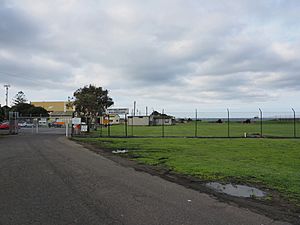Fort Gellibrand facts for kids
Quick facts for kids Fort Gellibrand |
|
|---|---|
 |
|
| Location | Morris Street, Williamstown, Victoria, Australia |
| Official name: Fort Gellibrand Commonwealth Area | |
| Type | Listed place (Historic) |
| Designated | 22 June 2004 |
| Reference no. | 105615 |
| Lua error in Module:Location_map at line 420: attempt to index field 'wikibase' (a nil value). | |
Fort Gellibrand is an old military fort in Williamstown, Victoria, Australia. It was built to help protect Melbourne from attacks by sea. This historic site was added to the Australian Commonwealth Heritage List on 22 June 2004, meaning it's a special place worth preserving.
Contents
Exploring Fort Gellibrand
Fort Gellibrand is divided into different areas. There's a section with most of the main buildings, a central area with gun positions and storage rooms, and an open space used for parades. Let's look at some of the important structures you can find there.
Drill Hall and Residence
The Drill Hall (Building 1) was built in 1884. It's a wooden building with a pointed roof and many windows. Soldiers used it for training, meetings, and administrative tasks. It's one of the oldest buildings at the Fort.
Next to it is a small house, possibly for a caretaker. This house is quite rare for a fort in Victoria. It's also made of wood and has a verandah.
Quartermaster's Store
The Quartermaster's Store (Building 5) was built in 1942. It's one of the biggest buildings at the Fort. It was originally used for testing anti-aircraft guns. This shows how the Fort's purpose changed over time.
Artillery Stores
There are several buildings that were used to store artillery and weapons.
- The former Artillery and Side Arms Store (Building 8) dates back to 1907. It's an early building on the site.
- The former Artillery Store (Building 9) is even older, from the 1860s. It's the only building from that time period that still stands above ground at Fort Gellibrand. It was designed by a famous engineer, Peter Scratchley.
- The General Store (Building 10) was built in 1940. It was used as a laboratory to help test artillery.
- The Side Arms Store (Building 11), also from 1940, stored smaller weapons.
Special Purpose Buildings
- The former Heating Chamber (Building 12) was built in 1938. It was used to heat and test ammunition. It was connected to the Boiler House (Building 21), which provided the heat. This building was quite unique for its time.
- The Sick Bay (Building 24) was built in 1942. It was first used as temporary housing for married soldiers. Later, in the 1950s, it became a sick bay for medical care.
- The Splinter-proof Shelter (Building 27) is a strong concrete bunker built between 1938 and 1942. It protected people during gun testing.
Underground Structures
The Old Magazine (Building 29) is an underground room. It was built in the 1860s and stored gunpowder and ammunition. It's one of the oldest parts of the Fort.
Parade Ground and Memorial
The Parade Ground (Building 30) is a large paved area. It has been in its current spot since the 1960s. There's a memorial stone and a flagpole at one end. This memorial honors soldiers from No.2 Commando Company who died during training.
Observation Posts
- The Observation Platform (Building 31) was built in the late 1930s or early 1940s. It's made of concrete and was used to watch gun tests.
- The Observation Shelter (Building 32) is another structure from around 1942. It also helped with the artillery testing range.
Defence Walls
The Infantry Parapet (Building 33) was built in the 1860s-70s. It's a stone wall that provided protection for soldiers between gun batteries.
Gun Emplacements
Fort Gellibrand has several gun emplacements, which are fortified positions for cannons.
- G5 is a gun emplacement from 1889. It was designed for a "disappearing gun." This type of gun could be lowered out of sight after firing to protect it.
- G6 is another gun emplacement and underground magazine from 1889. It held a smaller, quick-firing gun.
- G7 is similar to G5, also from 1889, and designed for a disappearing gun.
- G8 is the remains of a very old gun emplacement from 1861. It held different types of large guns over the years.
Why Fort Gellibrand is Important
Fort Gellibrand is the only major part left of the original defence system for Hobsons Bay. It was part of a network of forts built around Port Phillip Bay in the 1800s. These forts, like Fort Queenscliff and Fort Nepean, protected Victoria's capital, Melbourne.
The Fort is special because it shows how defence planning changed over time. It started as a coastal defence fort. Later, it became important for artillery training and testing new weapons.
Many of its buildings are good examples of military architecture from the late 1800s and 1900s. The Drill Hall, with its rare caretaker's residence, is unique. The old Artillery Store is the only one of its kind left from any of the Port Phillip Bay forts. The Heating Chamber also shows special technology used for testing ammunition. The gun emplacements show how gun and defence designs improved over the years.
Fort Gellibrand is also linked to important people like Lieutenant Colonel Peter Scratchley and Colonel Sir William Jervois. They were key figures in planning Australia's defences in the late 1800s.

